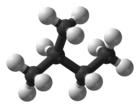Isopentane
Isopentane, also called methylbutane or 2-methylbutane, is a branched-chain saturated hydrocarbon (an alkane) with five carbon atoms, with formula C
5H
12 or CH(CH
3)
2(C
2H
5).
 | |
 | |
| Names | |
|---|---|
| Preferred IUPAC name
2-Methylbutane[1] | |
| Other names
Isopentane | |
| Identifiers | |
3D model (JSmol) |
|
| 1730723 | |
| ChEBI | |
| ChemSpider | |
| ECHA InfoCard | 100.001.039 |
| EC Number |
|
| 49318 | |
| MeSH | isopentane |
PubChem CID |
|
| RTECS number |
|
| UNII | |
| UN number | 1265 |
CompTox Dashboard (EPA) |
|
| |
| |
| Properties | |
| C5H12 | |
| Molar mass | 72.151 g·mol−1 |
| Appearance | Colorless liquid |
| Odor | Odorless |
| Density | 616 mg mL−1[2] |
| Melting point | −161 to −159 °C; −258 to −254 °F; 112 to 114 K |
| Boiling point | 27.8 to 28.2 °C; 81.9 to 82.7 °F; 300.9 to 301.3 K |
| Vapor pressure | 76.992 kPa (at 20 °C) |
Henry's law constant (kH) |
7.2 nmol Pa−1 kg−1 |
| UV-vis (λmax) | 192 nm |
Refractive index (nD) |
1.354 |
| Viscosity | 0.214 cP (at 20 °C) |
| Thermochemistry | |
Heat capacity (C) |
164.85 J K−1 mol−1 |
Std molar entropy (S |
260.41 J K−1 mol−1 |
Std enthalpy of formation (ΔfH⦵298) |
−179.1–−177.3 kJ mol−1 |
Std enthalpy of combustion (ΔcH⦵298) |
~ 3.3 MJ mol−1, 19,664 Btu/lb |
| Hazards | |
| GHS pictograms |     |
| GHS Signal word | Danger |
GHS hazard statements |
H224, H304, H336, H411 |
| P210, P261, P273, P301+310, P331 | |
| NFPA 704 (fire diamond) | |
| Flash point | −51 °C (−60 °F; 222 K) |
| 420 °C (788 °F; 693 K) | |
| Explosive limits | 1.4–8.3% |
| Related compounds | |
Related alkanes |
|
Related compounds |
2-Ethyl-1-butanol |
Except where otherwise noted, data are given for materials in their standard state (at 25 °C [77 °F], 100 kPa). | |
| Infobox references | |
Isopentane is an extremely volatile and extremely flammable liquid at room temperature and pressure. It is also the least dense liquid at standard conditions. The normal boiling point is just a few degrees above room temperature and isopentane will readily boil and evaporate away on a warm day.
Isopentane is commonly used in conjunction with liquid nitrogen to achieve a liquid bath temperature of −160 °C. Natural gas typically contains 1% or less isopentane,[3] but it is a significant component of natural gasoline.[4]
Nomenclature
The traditional name isopentane was still retained in the 1993 IUPAC recommendations,[5][6] but is no longer recommended according to the 2013 recommendations.[1] The preferred IUPAC name is the systematic name 2-methylbutane. An isopentyl group is a subset of the generic pentyl group. It has the chemical structure -CH3CH2CH(CH3)2.
Isomers
Isopentane is one of three structural isomers with the molecular formula C5H12, the others being pentane (n-pentane) and neopentane (dimethyl propane).
Uses
Isopentane is used in a closed loop in geothermal power production to drive turbines.[7]
Isopentane is used, in conjunction with dry ice or liquid nitrogen, to freeze tissues for cryosectioning in histology. [8]
Isopentane is a major component (sometimes 30% or more) of natural gasoline, an analog of common petroleum-derived gasoline that is condensed from natural gas.[4] It has a substantially higher octane rating (RON 93.7) than n-pentane (61.7), and therefore there is interest in conversion from the latter.[9]
References
- Nomenclature of Organic Chemistry : IUPAC Recommendations and Preferred Names 2013 (Blue Book). Cambridge: The Royal Society of Chemistry. 2014. p. 652. doi:10.1039/9781849733069-FP001. ISBN 978-0-85404-182-4.
The names ‘isobutane’, ‘isopentane’ and ‘neopentane’ are no longer recommended.
- James Wei (1999), Molecular Symmetry, Rotational Entropy, and Elevated Melting Points. Ind. Eng. Chem. Res., volume 38 issue 12, pp. 5019–5027 doi:10.1021/ie990588m
- Georg Hammer, Torsten Lübcke, Roland Kettner, Mark R. Pillarella, Herta Recknagel, Axel Commichau, Hans-Joachim Neumann and Barbara Paczynska-Lahme "Natural Gas" in Ullmann's Encyclopedia of Industrial Chemistry 2006, Wiley-VCH, Weinheim. doi:10.1002/14356007.a17_073.pub2
- Ivan F. Avery, L. V. Harvey (1958): Natural-gasoline and Cycling Plants in the United States, Information circular, U.S. Department of the Interior, Bureau of Mines. 12 pages.
- Table 19(a) Acyclic and monocyclic hydrocarbons. Parent hydrocarbons
- Panico, R.; & Powell, W. H. (Eds.) (1994). A Guide to IUPAC Nomenclature of Organic Compounds 1993. Oxford: Blackwell Science. ISBN 0-632-03488-2.CS1 maint: multiple names: authors list (link) CS1 maint: extra text: authors list (link)
- Byproduct Isopentane also used in some of the LPG plant to run the boiler and generate the power. HS Orka HF Energy Plant IV Archived 2014-10-18 at the Wayback Machine
- http://www.uab.edu/research/administration/offices/ARP/ComparativePathology/Pathology/Histopathology/TissueSubmission/Pages/Freezing-Tissues-for-Cryosectioning.aspx
- Sheng Wang, Ying Zhang, Mao-Gang He, Xiong Zheng, and Li-Bin Chen (2014): "Thermal Diffusivity and Speed of Sound of Saturated Pentane from Light Scattering". International Journal of Thermophysics, volume 35, pages 1450–1464. doi:10.1007/s10765-014-1718-x
External links
- International Chemical Safety Card 1153
- IUPAC Nomenclature of Organic Chemistry (online version of the "Blue Book")
